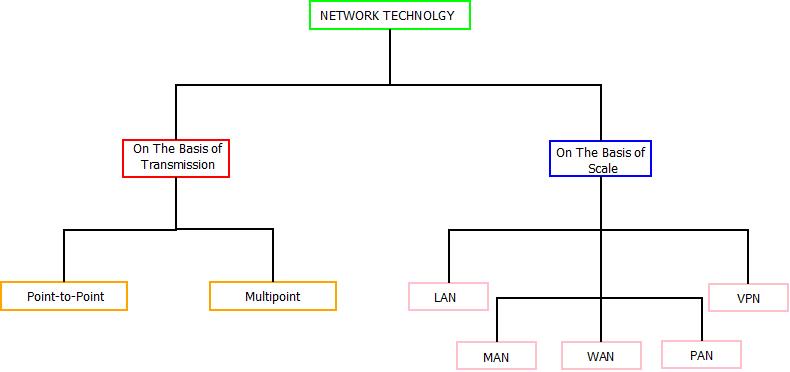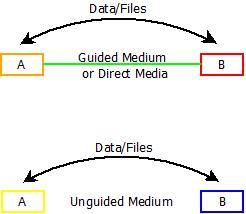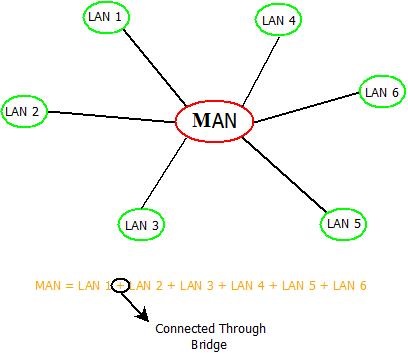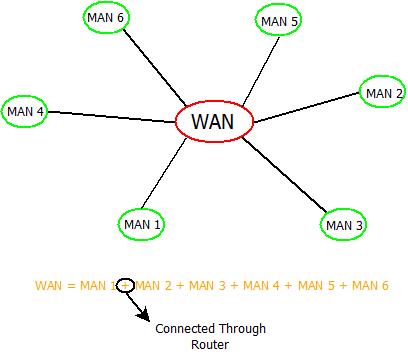Network Technology : Introduction
-
Network technology defines the concepts on which any network is
structured. This concept can be applied on any network on the
basis of:
- Transmission.
- Scale.
- Further, network technology on the basis of transmission can be done using point to point and multipoint concept.
- Data exchange and transmission can be done using network technology.

Network Technology : Computer Networks
Network Technology : On the Basis of Transmission
-
Point-to-Point
-
When nodes(Sender & Receiver) are directly connected, Data transmission is done through a guided medium for wired network and through unguided medium for wireless medium.

Point-to-Point : Network Technology
-
-
Multi-Point
-
A number of nodes are directly connected through a common medium in a linear fashion. It is like a one device to many device data transmission mode.
-
Concept of multi-point transmission works on either Time sharing connection or Spatially shared connection. In Time sharing connection, each node is offered a separate slot of time to communicate. But in Spatially shared connection, all the nodes can communicate simultaneously at a time.

Multi-point : Network Technology
-
Network Technology : On the Basis of Scale
-
Local Area Network(LAN)
- Local area network, also known as IEEE 802 is a network that comprises of devices such as laptops, computer & mobiles connected together within a small range. The range is from 100m to 10KM.
- Below mentioned table shows the properties of a local area network based upon its users, speed, range and error rate.

LAN Comparison
Elements of LAN- Peripheral Devices such as Scanners,Printers etc.
- HUBs: A HUB is called the center of a network which is responsible for absorbing the signals and is intelligent enough to transmit the data packets from source to destination node.
- Cables : Twisted Pair, Co-Axial cables and Optical Fibers. Optical Fiber is used as backbone cable because of its high bandwidth ability.
- Computers or Nodes or PC or Host or Server or Workstation.
- NIC : Network Interface Card.
-
Metropolitan Area Network(MAN)
- A network in which multiple Local Area Networks are combined together through a networking device called Bridge (Click To Know More..) forms a Metropolitan Area Network.

MAN : Network Technology -
Wide Area Network(WAN)
- A network in which multiple Metropolitan Area Networks are combined together through a networking device called Router (Click To Know More..) forms a Wide Area Network.
- Public Wan : It is handled by government departments.
- Private Wan : It was developed by US Military Department, Defence wing called as ARPANET.
- Bridge : It is a device which is used for connecting similar or dissimilar LANs.
- Router : It is a device which is used for connecting similar or dissimilar networks.
- Gateway : It is a device used for connecting networks with different types of architectures. For Example : Communication between a mobile device having 4G connection and landline device having 2G connection can be done using gateway.

WAN : Network Technology
Types of WANs
Elements of WAN
-
Personal Area Network(PAN)
- A network which is used for personal purpose and is created through Bluetooth or Wi-Fi to share data is called as Personal Area Network.
- For Example : Bluetooth Network, Wi-Fi hotspot.
-
Personal Area Network(PAN)
- A virtual private network is a private network which is established virtually over the public network in order to communicate and transmit data from one node to another. A user having a virtual private network access can transmit data anonymously without limitations.